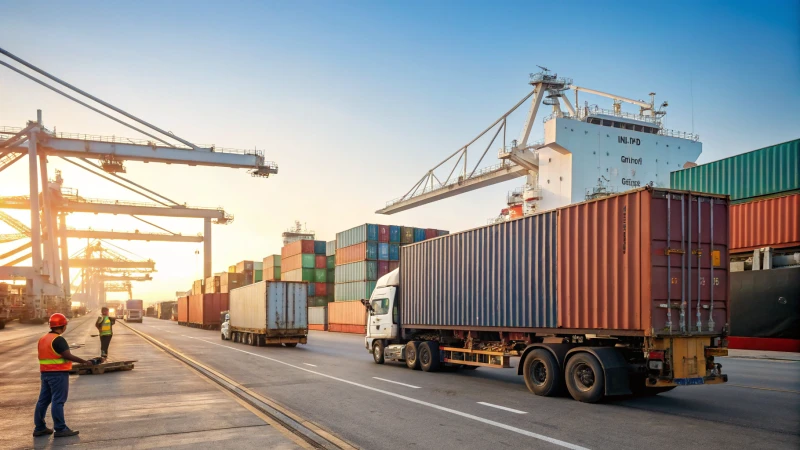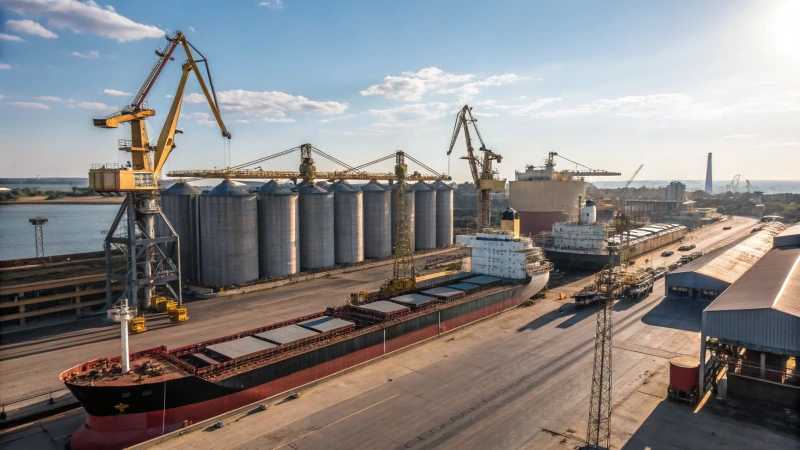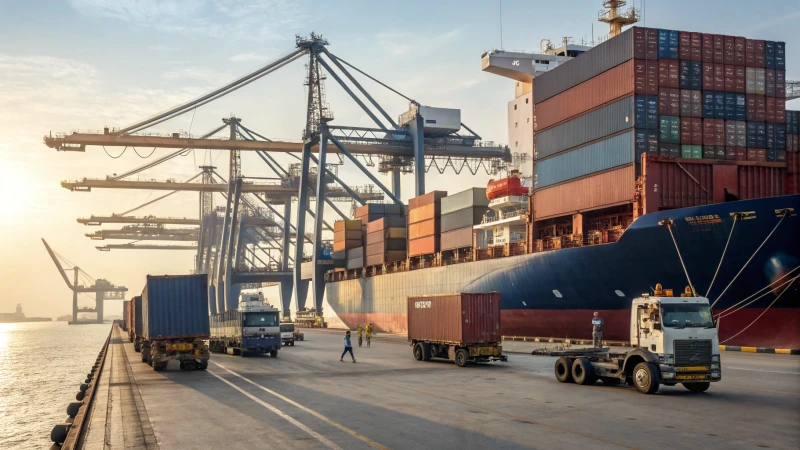Ever found yourself pondering the hustle and bustle of shipping terminals, wondering what magic happens there?
A shipping terminal is where the real action in logistics happens—it's the bustling hub where goods are transferred between ships, trucks, and trains. These terminals are essential for keeping global trade smooth by efficiently managing the movement, storage, and processing of cargo.
When I first dived into logistics, understanding terminal operations seemed like deciphering a complex puzzle. Each terminal type, from container to bulk, plays a unique role in ensuring that cargo moves seamlessly across the globe. Imagine standing at a container terminal; it’s like a well-orchestrated ballet of machinery and workers ensuring everything is in place.
The more I learned, the more I appreciated how these terminals make sure our shelves are stocked with everything we need. They’re not just about moving goods—they’re about keeping life as we know it, ticking along. Let’s delve deeper into how each type of terminal functions and its impact on the global supply chain.
Shipping terminals only handle sea freight.False
Terminals handle multiple transport modes like ships, trucks, and trains.
Terminals are crucial for efficient cargo movement.True
They facilitate the transfer, storage, and processing of goods.
How Do Container Terminals Operate?
Imagine a bustling port where massive ships glide in like giants delivering treasures from afar. It's in these vibrant spaces that container terminals spring into action, orchestrating a symphony of logistics.
Container terminals function through synchronized operations including unloading/loading, storage, and customs clearance. They use specialized equipment like gantry cranes and automated guided vehicles to efficiently manage containerized cargo.
Key Operations at Container Terminals
I've always been fascinated by the sheer scale and precision of container terminals—it's like watching a well-rehearsed ballet. The process kicks off as soon as these colossal ships dock.
-
Unloading and Loading
I remember standing by the docks, watching in awe as gantry cranes1 deftly lifted containers from the towering ships onto trucks or Automated Guided Vehicles (AGVs). Each container is tagged and tracked meticulously, a testament to the precision required.
-
Storage and Stacking
Once on solid ground, containers are ushered to storage areas. It’s a bit like organizing a giant game of Tetris with straddle carriers2 doing the heavy lifting. These machines expertly stack the containers to maximize space and ensure easy retrieval.
Step Equipment Used Purpose Unloading Gantry Cranes, AGVs Transfer containers from ship to terminal Storage Straddle Carriers Efficient stacking and retrieval -
Customs and Inspection
Next comes the crucial customs phase. It reminds me of those times at airports when you’re waiting for your bags and hoping everything goes smoothly. Customs inspections3 ensure all regulations are met, safeguarding international trade.
-
Dispatch and Transfer
Finally, it's time for dispatch. This step is all about coordination—like organizing a convoy of ants—moving containers to their next destination, whether by rail, road, or another sea voyage. Planning is everything here.
Advanced Technologies in Use
In recent years, technology has revolutionized these terminals. I’ve seen firsthand how automated terminals4 enhance efficiency with minimal human intervention, managing cranes and vehicle movements almost seamlessly.
These advancements not only speed up operations but also significantly boost safety by reducing manual handling risks. Understanding these intricate systems offers a glimpse into the vital role they play in global trade, ensuring goods traverse borders smoothly and swiftly.
Gantry cranes are used for unloading containers at terminals.True
Gantry cranes lift containers from ships to trucks or AGVs.
Customs inspections are optional at container terminals.False
Inspections are crucial for compliance with trade regulations.
What are the key functions of freight terminals?
Imagine standing amidst the hustle of a freight terminal, where every container tells a story of its journey across the globe.
Freight terminals are like the heartbeat of global logistics—they ensure goods are transferred smoothly between transport modes, offer storage solutions, expedite customs clearance, sort cargo efficiently, and provide vital maintenance services.

Facilitating Cargo Transfer
Have you ever watched a ship dock at a bustling port and marveled at how quickly goods move from massive ships to waiting trucks or trains? That's the magic of a freight terminal at work. I remember the first time I visited one; it was like watching a well-rehearsed dance. These terminals are critical in ensuring goods flow seamlessly across different transportation modes, whether it's by land, sea, or rail. This cross-modal transfer5 is essential for efficient delivery, making every link in the supply chain as strong as the next.
Providing Storage Solutions
During my adventures in logistics, I’ve realized that storage isn’t just about keeping goods until they move along. It's about ensuring their safety and quality. Freight terminals offer varied storage options, from basic warehouses to high-tech, climate-controlled units for sensitive goods. I once heard a story about a shipment of chocolate being saved from melting disaster thanks to such climate-controlled storage. Who knew logistics could also be about saving sweets?
| Type of Storage | Description |
|---|---|
| Temporary Storage | Short-term holding before onward transit |
| Long-term Storage | Prolonged holding, often for inventory |
Customs Clearance and Inspection
Anyone who’s dealt with international shipping knows that customs can feel like a complex maze. Freight terminals simplify this with on-site customs facilities, smoothing the process of inspection and clearance6. I recall my first time overseeing a shipment through customs—it was daunting! But with the right terminal processes in place, what seemed like an impenetrable barrier became just another step in the journey.
Sorting and Organizing Goods
Sorting might seem mundane, but it’s crucial for the quick transfer of goods. With advanced technologies like automated sorting systems, freight terminals make this process faster and more accurate. Imagine a giant puzzle being solved piece by piece—every item finds its place seamlessly, ready for the next leg of its journey.
Maintenance and Repair Services
Just like any vehicle needs regular check-ups to keep running smoothly, transportation equipment does too. Some freight terminals offer maintenance services to ensure everything is in top condition. This minimizes breakdowns and keeps operations moving without a hitch. I once toured a terminal's maintenance facility and was amazed by the precision and care they took to ensure every machine was ready for action.
Understanding these functions has helped me appreciate the intricacies of logistics. It’s a world where efficiency meets meticulous planning, ensuring that whether it's fashion accessories or everyday essentials, everything reaches its destination just as planned.
Freight terminals provide climate-controlled storage.True
Climate-controlled units are offered for perishable items at terminals.
All freight terminals offer maintenance services.False
Only some terminals provide maintenance for vehicles and equipment.
Why Are Bulk Terminals Essential for Certain Industries?
Ever wondered how industries manage to move massive quantities of goods like coal and grain so efficiently?
Bulk terminals are crucial for industries as they specialize in handling unpackaged goods such as coal and grain. They enhance operational efficiency with specialized equipment, ensuring smooth logistics and cost-effective distribution.

The Role of Bulk Terminals in Industry Logistics
Imagine watching a giant puzzle being assembled right before your eyes, each piece fitting perfectly into place, making the whole operation look effortless. That’s how I see bulk terminals—they’re the unsung heroes of the supply chain, seamlessly managing the flow of large quantities of unpackaged goods. These facilities are equipped with specialized equipment7 like conveyor belts and silos, making the loading, unloading, and temporary storage of bulk materials appear almost magical.
Industries Benefiting from Bulk Terminals
During my early days in logistics, I remember visiting a bulk terminal and being awestruck by its scale and efficiency. It was like stepping into a well-oiled machine. Here’s how different industries leverage these incredible hubs:
- Agriculture: Farmers rely on bulk terminals to store their grains safely in silos before they embark on their journey across the world. It's like a pit stop for crops, ensuring they stay fresh and safe.
- Mining: Picture mountains of coal being moved with the grace of a ballet dancer. That's what happens at these terminals, thanks to advanced conveyor systems8.
| Industry | Primary Goods | Terminal Features |
|---|---|---|
| Agriculture | Grain | Silos |
| Mining | Coal | Conveyor belts |
| Chemicals | Liquids | Pipelines |
Specialized Handling for Diverse Cargo
Every time I see a liquid bulk terminal, it reminds me of those sci-fi movies with sprawling complexes full of futuristic pipes and tanks. These terminals are designed to handle chemicals and petroleum products with utmost precision.
- Liquid Bulk Terminals: Think of them as the ultimate mixologists, equipped with pipelines and tanks for efficient handling.
- Dry Bulk Terminals: They tackle materials like cement or fertilizer using hoppers and cranes9 with the finesse of a circus performer.
Enhancing Supply Chain Efficiency
What always amazes me about bulk terminals is their ability to cut down on transportation costs and speed up turnaround times. This efficiency isn't just good for the bottom line; it’s also eco-friendly. By centralizing logistics operations, these terminals help industries move high-volume goods swiftly and sustainably. They're not just a cog in the global supply chain; they're the linchpin that holds everything together.
Bulk terminals reduce transportation costs for industries.True
Centralized logistics operations in bulk terminals lower costs by optimizing load and shipment methods.
Bulk terminals only handle dry goods like grain and coal.False
They also manage liquid cargo, using pipelines and tanks for chemicals and petroleum.
How Do Ro-Ro Terminals Facilitate Vehicle Shipping?
Ever wondered how your car smoothly makes its way across the globe on a ship? It’s all thanks to Ro-Ro terminals, the unsung heroes of vehicle shipping.
Ro-Ro terminals facilitate vehicle shipping by providing ramps that allow vehicles to drive directly onto ships, significantly reducing handling time. These terminals boost efficiency with dedicated facilities for storing, inspecting, and preparing vehicles for transport.
Understanding Ro-Ro Operations
Imagine watching your car simply drive onto a ship like it's heading for a ferry ride across a river. That's the magic of Ro-Ro10 (Roll-on/Roll-off) terminals. These specialized facilities are equipped with ramps that vehicles use to roll right onto the vessel, cutting down on manual handling and the risk of damage. I remember the first time I saw this in action; it was fascinating to see such efficiency. The ships themselves are marvels of engineering, boasting multiple decks and secure parking areas, making them perfect for everything from cars to heavy machinery.
Advantages of Ro-Ro Terminals
One day, I found myself in a bustling terminal, watching in awe as dozens of vehicles were loaded with impressive speed and precision. This high volume handling is a major advantage of Ro-Ro terminals. For businesses like mine, where timely delivery is crucial, the minimal delays are a game-changer. These terminals aren't just about moving cars; they offer comprehensive services like storage, inspections, and even maintenance before shipment. This not only eases logistical challenges but also reassures me that my shipments are in good hands.
| Feature | Benefit |
|---|---|
| Direct Loading | Faster turnaround time |
| Secure Parking | Safe storage during transit |
| Specialized Services | Pre-shipment inspections |
Comparing Ro-Ro with Container Shipping
There was a time when I pondered over whether to use container shipping11 instead. Container shipping involves loading vehicles into containers, which can be a bit of a hassle compared to the straightforward drive-on/off process of Ro-Ro terminals. Plus, it's often more costly and time-consuming. For someone needing to move large quantities of vehicles efficiently, Ro-Ro's simplicity and speed make it an attractive option.
Challenges in Ro-Ro Shipping
Of course, it's not all smooth sailing. Ro-Ro shipping can be at the mercy of weather conditions and congestion during peak times at terminals. I’ve had to plan around these issues to ensure smooth operations. Securing vehicles aboard is crucial to avoid any potential damage during transit. But with careful planning and efficient logistics management, these challenges can be effectively navigated.
For more insights into how logistics12 are managed in Ro-Ro operations, explore further resources that detail the intricacies of vehicle transit across the globe.
Ro-Ro terminals use ramps for direct vehicle loading.True
Ro-Ro terminals have ramps allowing vehicles to drive directly onto ships.
Container shipping is quicker than Ro-Ro shipping.False
Ro-Ro shipping is often quicker due to its streamlined drive-on/off process.
How Do Ports Differ from Terminals?
Ever stood at a bustling port and wondered, "What's the real difference between a port and a terminal?
Ports are expansive areas where ships dock, hosting commercial activities and multiple terminals. Terminals are specialized sections within ports, dedicated to specific cargo or passenger operations.
The Definition and Function of Ports
I remember the first time I stood at the edge of a massive port, the air filled with the salty tang of the sea and the rumbling of cranes. It was overwhelming yet fascinating to see how a port operates. A port is essentially an enormous hub where ships come to dock, unload, and load goods. It's like a busy little city with its own ecosystem, bustling with warehouses, cranes, and customs facilities. Each time I visit, I'm struck by its vastness and how it seamlessly supports global trade.
| Feature | Port |
|---|---|
| Scope | Entire area where ships dock |
| Function | Facilitate commercial activities |
| Infrastructure | Warehouses, cranes, customs facilities |
Understanding Terminals Within Ports
Now, think of terminals as the specialized departments within this bustling hub. Each terminal has a unique role, kind of like how different sections of a department store serve specific purposes. Whether it's containers being transferred or cars rolling on and off ships, terminals ensure these processes are efficient and orderly. They're specialized for particular tasks, making them essential to the smooth running of any port.
| Feature | Terminal |
|---|---|
| Scope | Specific facility within a port |
| Function | Handle specific cargo or passengers |
| Specialization | Container transfer, bulk handling |
Key Differences in Operations
When I think about port operations, I see them as the grand coordinators of maritime logistics—managing everything from docking to compliance with international laws. It's fascinating to see the precision with which they handle such complex tasks. In contrast:
- Port Operations: These involve a broader range of activities including overall management of the docking area, coordination with multiple terminals, and ensuring compliance with international shipping regulations13. Ports serve as main entry and exit points for global trade.
- Terminal Operations: Each terminal focuses on streamlined processes for its specific cargo type. For instance, a container terminal might operate like a well-oiled machine prioritizing quick transfers while a passenger terminal might feel more like a mini-airport with ticketing and customs services.
Coordination Between Ports and Terminals
It's crucial for ports to coordinate effectively with their terminals—kind of like a well-choreographed dance. This coordination ensures that everything runs smoothly from managing ship traffic to scheduling arrivals and departures. When I observe this harmony in action:
- Terminals must work closely with the overarching port authority to optimize resources and prevent delays.
- By understanding these dynamics businesses can better strategize their shipping plans to enhance reliability across their supply chains.
By understanding these distinctions and their respective roles in maritime logistics:
Ports encompass multiple terminals.True
Ports include several terminals, each for specific cargo types.
Terminals manage entire port operations.False
Terminals focus on specific cargo; ports manage overall operations.
Conclusion
Shipping terminals are vital logistics hubs facilitating the transfer, storage, and processing of cargo between ships, trucks, and trains, ensuring efficient global trade operations.
-
Gantry cranes are essential for loading and unloading containers efficiently from ships. ↩
-
Straddle carriers are vital for stacking containers efficiently in terminal yards. ↩
-
Understanding customs processes helps in comprehending legal compliance in shipping. ↩
-
Automated terminals represent the future of efficient and safe container handling. ↩
-
Explore how terminals enable smooth cargo transitions between transport modes, enhancing delivery efficiency. ↩
-
Learn how customs processes at terminals expedite goods inspection and clearance, reducing delays. ↩
-
Discover the advanced equipment used in bulk terminals to streamline the handling and processing of various goods. ↩
-
Learn how conveyor systems enhance the efficiency of bulk material handling at industrial terminals. ↩
-
Explore how cranes are utilized in dry bulk terminals to manage heavy loads effectively. ↩
-
Exploring this link provides insights into the design and capacity of Ro-Ro vessels, enhancing your understanding of their operational efficiencies. ↩
-
Learn about the complexities of container shipping for vehicles compared to Ro-Ro methods by clicking this link. ↩
-
This link offers a deeper look into the logistics management of Ro-Ro terminals, including handling and operational strategies. ↩
-
Discover how ports function as crucial nodes in global trade networks. ↩
-
Learn about the different terminal types to understand their specialized functions. ↩
-
Understand the essential components of port infrastructure to appreciate their complexity. ↩




